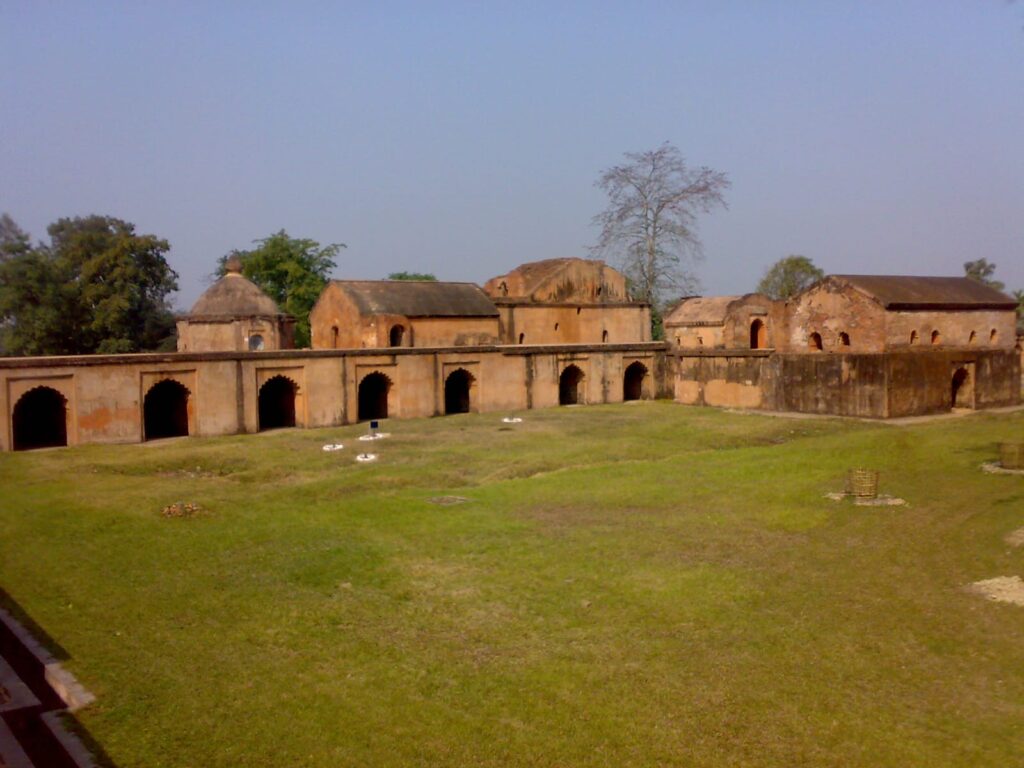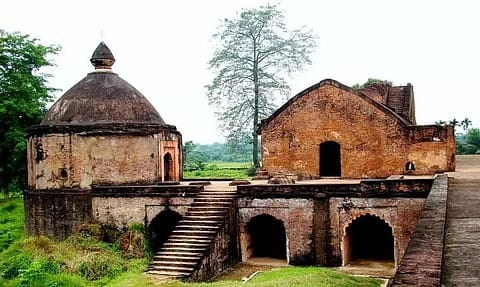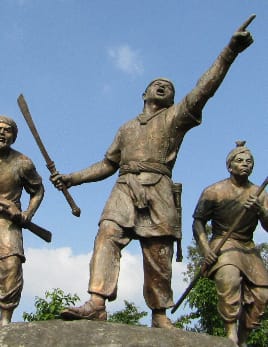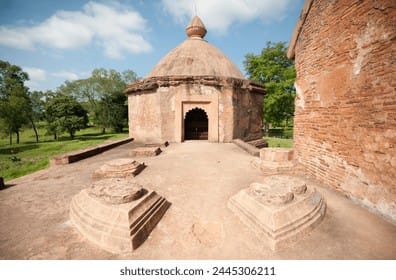
Introduction
In the heart of Northeast India lies a legacy that has stood the test of time—The Ahom Dynasty of Assam. While much of Indian history revolves around the Mauryas, Mughals, or Marathas, the Ahoms wrote their own heroic saga for over 600 years (1228–1826 CE)—an uninterrupted dynasty that not only preserved its sovereignty but defeated the mighty Mughals 17 times. These legendary warriors guarded India’s eastern gate like an iron shield and left behind a rich cultural, military, and administrative heritage.
This blog explores their glorious rule (Ahom Dynasty), the titles of their monarchs, administrative brilliance, cultural contributions, and fascinating stories that still echo through the Brahmaputra Valley.
Founding of the Ahom Dynasty: A Tai Gift to Bharat
The Ahoms originated from the Tai ethnic group, which migrated from the Yunnan province (modern-day China). Led by Chaolung Sukaphaa, a prince from Mong Mao, they crossed the rugged Patkai Hills and entered the Brahmaputra Valley in 1228 CE.
Sukaphaa, unlike many conquerors, did not seek to impose but to integrate. He married local Assamese women and encouraged Tai-Ahom and indigenous cultural fusion. This gave birth to a stable, deeply rooted civilization in Upper Assam.
First Ahom King (Ahom Dynasty):
Chaolung Sukaphaa (1228–1268 CE) – The Founder and Integrator
👑 Complete List of Ahom Kings (1228–1826 CE) Ahom Dynasty
The Ahom Dynasty had 41 kings who ruled uninterruptedly for nearly 598 years. Here’s a detailed timeline of their reigns:
| No. | Name of the King | Reign Period | Notes |
|---|---|---|---|
| 1 | Chaolung Sukaphaa | 1228–1268 | Founder of the Ahom dynasty |
| 2 | Sukhranphaa | 1268–1281 | Son of Sukaphaa |
| 3 | Subinphaa | 1281–1293 | Consolidated territory |
| 4 | Sukhaangphaa | 1293–1332 | Expanded westward |
| 5 | Sutuphaa | 1332–1364 | Assassinated |
| 6 | Tyaokhamti | 1364–1380 | Short rule, killed in conflict |
| 7 | Sukhangphaa | 1380–1397 | Known for diplomacy |
| 8 | Sutuphaa II | 1397–1407 | Also known as Sujangphaa |
| 9 | Suphakphaa | 1422–1439 | Known for stability |
| 10 | Susenphaa | 1439–1488 | Longest reigning ruler |
| 11 | Supimphaa | 1488–1493 | Short rule |
| 12 | Suhungmung (Dihingia Raja) | 1497–1539 | Adopted Hindu titles; defeated Chutia kingdom |
| 13 | Suklenmung (Gargaya Raja) | 1539–1552 | Built palaces and forts |
| 14 | Sukhaamphaa (Khora Raja) | 1552–1603 | Defeated Kacharis |
| 15 | Susengphaa (Pratap Singha) | 1603–1641 | Adopted Hindu name; strong administration |
| 16 | Suramphaa (Bhaganya Raja) | 1641–1644 | Short, unstable rule |
| 17 | Sutamla (Jayadhwaj Singha) | 1648–1663 | Faced Mughal invasion of 1662 |
| 18 | Supangmung (Chakradhwaj Singha) | 1663–1670 | Recovered Guwahati, revived Ahom spirit |
| 19 | Sunyatphaa (Udayaditya Singha) | 1670–1672 | Patron of arts |
| 20 | Ramdhwaj Singha | 1672–1674 | Limited rule |
| 21 | Suhung (Phukanmung) | 1674–1675 | Brief reign |
| 22 | Gobar Raja | 1675 | Puppet king |
| 23 | Gadadhar Singha (Supatphaa) | 1681–1696 | Strong monarch; restored stability |
| 24 | Rudra Singha | 1696–1714 | Great builder and warrior king |
| 25 | Siva Singha | 1714–1744 | Devout Vaishnavite, built temples |
| 26 | Pramatta Singha | 1744–1751 | Peaceful rule |
| 27 | Rajeswar Singha | 1751–1769 | Faced Moamoria tensions |
| 28 | Lakshmi Singha | 1769–1780 | Moamoria Rebellion broke out |
| 29 | Gaurinath Singha | 1780–1795 | Weak ruler, lost control |
| 30 | Kamaleswar Singha | 1795–1810 | British interference began |
| 31 | Chandrakanta Singha | 1811–1818 | Lost throne once, restored briefly |
| 32 | Purandar Singha | 1818–1819 & 1833–1838 | Last titular ruler under British |
📝 Note: After the Treaty of Yandabo in 1826, Assam was officially annexed by the British East India Company.
Adventure tourism Assam 2025 Assam travel destinations
Titles and Administration of the Ahom Dynasty
Royal Titles:
- Swargadeo – “Lord of the Heavens” (equivalent to Emperor)
- Chao – Tai-Ahom word for prince or lord
- Borpatrogohain, Borgohain, Burhagohain – Chief ministers with military and civil duties
- Borphukan, Barbaruah – Provincial and military governors
The Ahom polity was both centralized and feudal, based on a strong bureaucratic structure called the Paik system—a labor-based military and civil administration model. Every adult male (called a “Paik”) had to render military or civil service to the state.

Military Prowess: The Mughal Defeats
Between the 1600s and 1700s, the Ahoms clashed with the Mughals 17 times—and emerged victorious in nearly all.
Most Iconic Battle: The Battle of Saraighat (1671)
Led by the legendary Lachit Borphukan, the Ahoms defeated Aurangzeb’s forces led by Ram Singh I.
- Fought on the Brahmaputra River, the Ahoms used guerrilla tactics and naval warfare brilliantly.
- Lachit’s leadership, even while terminally ill, turned the tide.
- His commitment is immortalized in his words:
“My lord, my country comes first, not my uncle!” – when he ordered his uncle’s execution for neglect of duty.
Cultural and Religious Achievements of Ahom Dynasty
- Assimilation of Tai-Ahom, Assamese, and Sanskritic elements
- Patronage to Vaishnavism under saints like Srimanta Sankardeva
- Construction of temples like Rang Ghar, Talatal Ghar, Kareng Ghar
- Promotion of Ahom script, manuscripts, and literature
Fascinating Stories from the Ahom Dynasty
The Story of Lachit Borphukan’s Sword and Uncle
One of the most iconic figures in Indian history (Ahom Dynasty), Lachit Borphukan was the General of the Ahom army who led the decisive Battle of Saraighat (1671 CE) and successfully defeated the Mughal army led by Raja Ram Singh I, sent by Aurangzeb.
🌱 Early Life & Rise to Power
- Born: 1622, in the Ahom Kingdom (present-day Assam)
- Father: Momai Tamuli Borbarua – an important Ahom official and reformer
- Lachit was well-educated in warfare, diplomacy, and statecraft
- He rose through the ranks and was appointed the Borphukan—governor and military commander of the Western Front (Guwahati region)

⚔️ Context: Why Did the Mughals Invade?
After the death of Mughal commander Mir Jumla in 1663, the Mughals wanted to reassert control over Assam.
- Aurangzeb sent a massive force under Raja Ram Singh I of Amber with the goal to capture Guwahati and subdue the Ahoms.
- The Mughal army included 30,000 infantry, 18,000 cavalry, 2,000 archers, and numerous war elephants and cannons.
🛡 Battle of Saraighat: The David vs. Goliath Fight (1671 CE)
- Took place on the Brahmaputra River near Guwahati.
- Lachit, suffering from fever, refused to abandon the battlefield.
- Under his command, the Ahoms:
- Used small but agile boats
- Employed guerrilla and river warfare
- Used decoys, river traps, and speed to destroy Mughal vessels
- He famously ordered his uncle’s execution for not building fortifications on time, saying: “Deshote konba dangor? Mor logote dangor nohoi!”
(“What is bigger—the country or my uncle? My country comes first!”)
🏆 Victory and Aftermath
- The Mughals were forced to retreat, suffering huge losses.
- Lachit’s leadership became a symbol of Assamese patriotism and national pride.
- Unfortunately, he died a year later in 1672, likely due to chronic illness.
🏅 Legacy of Lachit Borphukan
- His statue stands proudly at Saraighat, and at NDA, Pune.
- Lachit Divas is celebrated on November 24th every year in Assam.
- The Lachit Borphukan Gold Medal is awarded to the best cadet at India’s National Defence Academy (NDA).
In 2022, Prime Minister Narendra Modi paid tribute to Lachit Borphukan on his 400th birth anniversary, recognizing him as a “national hero who protected India’s identity.”
King Rudra Singha’s Imperial Dream
Rudra Singha (1696–1714), an ambitious monarch, dreamed of expanding the Ahom Empire across Bengal and the North Indian plains. He sent envoys to forge an alliance with the Marathas and Sikhs, but died before the grand campaign could begin.
His death marked the end of Ahom expansionism, yet his vision remains a symbol of Assamese pride.
The Mystery of the Talatal Ghar’s Secret Tunnels
The Talatal Ghar in Sivasagar, a palace and military base, reportedly had secret tunnels leading to the Dikhow River. These were escape routes in case of siege. Though now sealed, the tunnels have fascinated archaeologists and treasure hunters for years.

A Divine Sign: How a White Elephant Chose the Capital
When King Gadadhar Singha was looking to establish a new capital, he let a white elephant roam freely. Where it rested would be the site of his kingdom’s capital. It chose Rangpur, which became one of the most beautiful cities of Ahom Assam.
The British Backdoor and the Betrayal
The final blow to the Ahom dynasty came not through war, but manipulation. The British East India Company took advantage of internal dissension, especially during the Moamoria Rebellion, and slowly usurped power. In 1826, with the Treaty of Yandabo, Assam was annexed to British India.
Legacy of the Ahom Dynasty
- 600+ years of continuous rule—a rarity in Indian history
- Military brilliance and anti-Mughal resistance
- Preserved Assamese identity, culture, and language
- A blend of Tai roots and Hindu traditions
- Contributions to art, engineering, architecture, and literature
🏛 Recognition in Modern Times: NCERT Includes the Ahom Dynasty
For decades, the Ahom Dynasty remained underrepresented in mainstream Indian history textbooks, despite their unmatched military resilience and cultural legacy. However, after growing public demand and academic acknowledgment, the NCERT (National Council of Educational Research and Training) finally included the Ahoms in its official history curriculum.
- In 2022–23, the NCERT history books were revised to feature the glorious contributions of the Ahom Dynasty, especially their victories against the Mughals.
- This move was praised by scholars and cultural activists across Assam and the Northeast as a major step towards inclusive Indian historiography.
- It highlights key events like the Battle of Saraighat, the Paik system, and the integration policies of Chaolung Sukaphaa.
This acknowledgment in national education ensures that future generations learn about one of India’s longest-ruling dynasties (Ahom Dynasty), not as a regional footnote, but as a pillar of India’s historical identity.
Visit Kaziranga National Park – The Kingdom of the One-Horned Rhino
✅ Updated Conclusion
The Ahoms were not just rulers—they were guardians of Bharat’s eastern frontier, brilliant administrators, tolerant integrators, and brave warriors who stood unshaken for over six centuries.
Their victory over the Mughals 17 times, their unique administrative systems like the Paik system, their architectural marvels like the Rang Ghar, and their unwavering patriotism—make them one of the greatest dynasties in Indian history.
And now, with the NCERT including their story in history textbooks, the Ahoms are finally receiving the national recognition they long deserved. Their saga will inspire millions of young Indians to take pride in the resilience, unity, and cultural richness of our eastern frontiers.
🌄 Plan Your Trip to Northeast India with Us!
Want to explore the untouched beauty of the Northeast?
From the misty mountains of Mizoram to the living root bridges of Meghalaya, and the cultural heart of Assam — we’ve got you covered!
✅ Personalized Travel Itinerary
✅ Local Guides & 24/7 Support
✅ Best Hotel & Homestay Options
✅ Group Tours & Solo Packages
✅ Affordable, Safe & Hassle-Free
📩 Contact us today and let’s start planning your dream trip!
📞 Call/WhatsApp: 8453980642
🧳 Book your Northeast adventure now – Discover places you’ve only dreamed of!
